21 JANUARY – 03 FEBRUARY 2024
By Eduardo Ormaeche
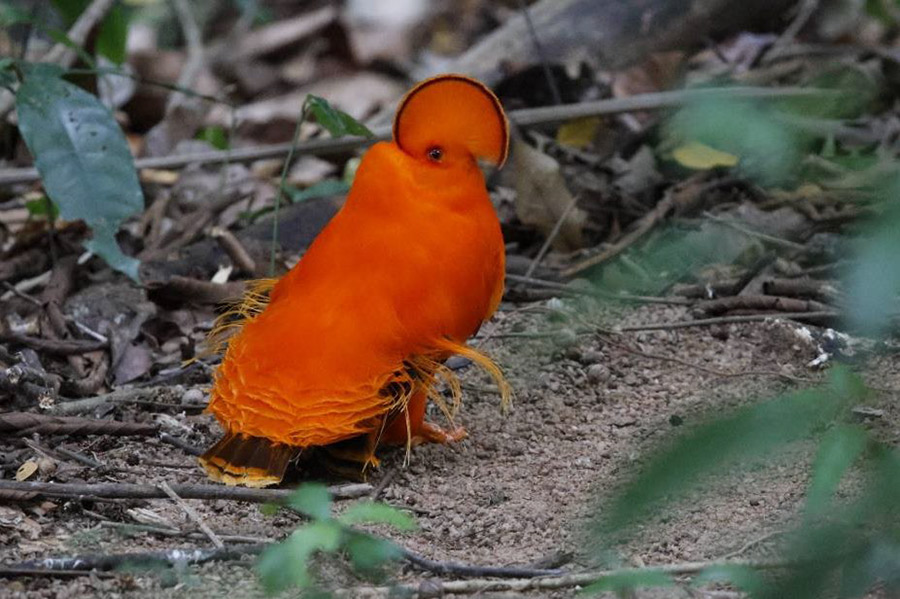
Guianan Cock-of-the-rock (photo Sue Bryan).
Overview
I had the privilege of leading a Guyana birding tour from 21 January to 03 February 2024. The five wonderful participants were absolutely keen on birds and wildlife and very enthusiastic about our adventure exploring this little-visited South American country.
Our two-week birding adventure began by visiting the coast at Georgetown to look for some special birds such as Scarlet Ibis, Rufous Crab Hawk, Blood-colored Woodpecker, White-bellied Piculet, and Festive Amazon.
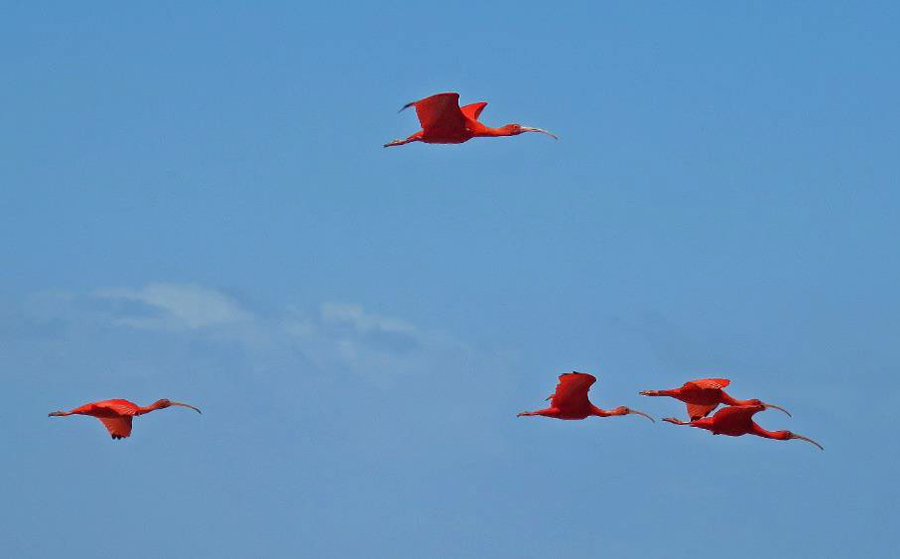
Scarlet Ibis flying along the coast (photo John Geeson).
We then flew to (and above) Kaieteur Falls, an amazing waterfall with a single drop of 741 feet (226 meters) – higher than either Niagara or Victoria Falls – but less well-known. This was an amazing place to start the trip. We could see the highlands of Guyana below, which are totally inaccessible, enjoy the dramatic scenery, and appreciate the pristine rainforest. Nevertheless, we were saddened by the threat of “progress”. Large deposits of gold, diamonds, bauxite and crude oil (from the ocean) increased Guyana’s GDP by 43% in 2020. Everything seems to indicate that Guyana’s economy is on a firm upward trend, hopefully the pristine rainforest will be cherished, valued and preserved.
In the rainforest we had fabulous encounters with species such as Pompadour Cotinga, Capuchinbird, Guianan Red Cotinga, Guianan Cock-of-the-rock, Red-fan Parrot, Black Curassow, Grey-winged Trumpeter, White-winged Potoo, Guianan Toucanet, Guianan Puffbird, Guianan Trogon, Rufous-throated Antbird, Waved Woodpecker, White-plumed Antbird and Rufous-winged Ground Cuckoo.
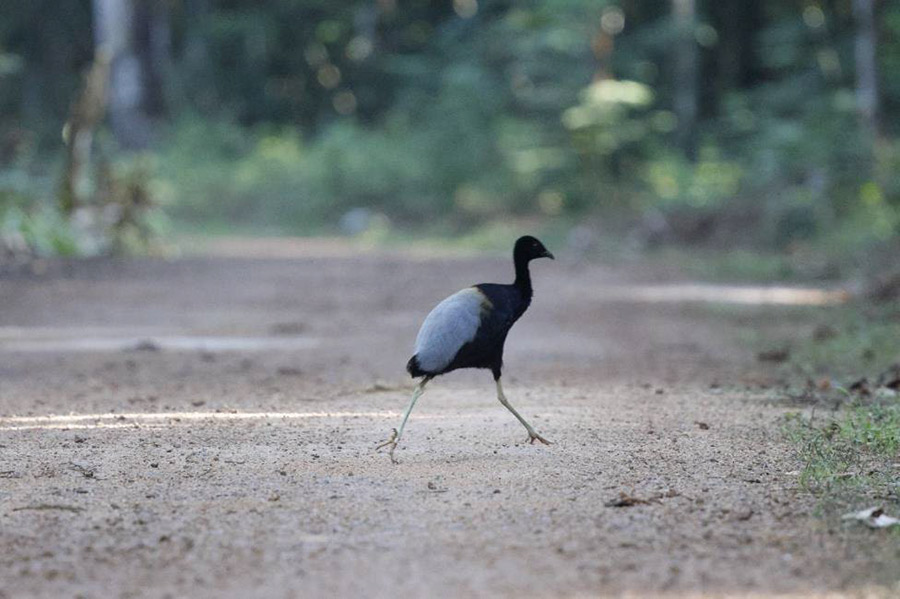
Grey-winged Trumpeter near Iwokrama River Lodge (photo Sue Bryan).
We then moved on to the savanna, a part of the country which has even fewer foreign visitors. Here, we saw some highly threatened species, considered among the rarest on the continent, such as Red Siskin, Sun Parakeet, Rio Branco Antbird, Hoary-crested Spinetail. Other specials included Bearded Tachuri, Crested Doradito and Least Nighthawk.
This tour had it all; charter flights above unbroken forest, walks in the rainforest interior, canopy walkways through the treetops, boat rides and 4×4 drives. It was so much fun and a great adventure!
Detailed Report
Day 1, 21st January 2024. Arrival in Georgetown and transfer to Cara Lodge
The participants arrived in Georgetown, flying in from Miami and Barbados, and were met by the Birding Ecotours staff. It was a one-hour drive from Cheddi Jagan International Airport to Cara Lodge Hotel. Everyone was excited for our adventure starting the next day.
Day 2, 22nd January 2024. Exploring Mahaica River, Ogle Mud Flats and Guyana Botanical Gardens
After breakfast we went to a small dock to board a boat and explore the Mahaica River, a small river that drains into the Atlantic Ocean. The boat trip was great fun and a good introduction to the birds of Guyana. We managed to see interesting aquatic species such as Yellow-hooded Blackbird, Yellow Oriole, Carib Grackle, Black-capped Donacobius, and Amazon, Green and American Pygmy Kingfishers. Raptors included Black-collared Hawk, Snail Kite, Great Black Hawk and Long-winged Harrier.
Other species proved more difficult, but we managed Silvered Antbird, Coraya Wren, Yellow-chinned Spinetail and bad light did not stop us from enjoying our first Green-tailed Jacamar, although we did get better views later in the trip. We had great views of Guyana’s national bird, Hoatzin, and were rewarded with views of Giant (River) Otter fishing in the peaceful waters of the Mahaica River. Other species included Lesser Yellow-headed Vulture, Green Ibis, Striated Heron, Snowy Egret, Tricolored and Little Blue Herons, Great Egret, Limpkin, Southern Lapwing, Yellow-crowned and Orange-winged Amazons, Blue-and-yellow Macaw, Brown-throated Parakeet, Bat Falcon, Laughing Falcon, Lineated Woodpecker, a glimpse of Little Cuckoo (the only sighting of the trip), Cayenne Jay, White-winged Swallow and Grey-breasted Martin.
Back on the mainland, we had a great time checking the Ogle Mud Flats, where we had amazing views of the most-wanted Scarlet Ibis, as well as other interesting species like Semipalmated Plover, Spotted and Solitary Sandpipers, Greater and Lesser Yellowlegs, Willet and Hudsonian Whimbrel. In addition to these birds, we found Black-crowned and Yellow-crowned Night Herons, Tricolored Heron, Black Skimmer, Royal Tern and Brown Pelican. We also suddenly had a glimpse of a Small Indian Mongoose (introduced to Guyana and the Caribbean in the 19th century) amongst the mangroves.
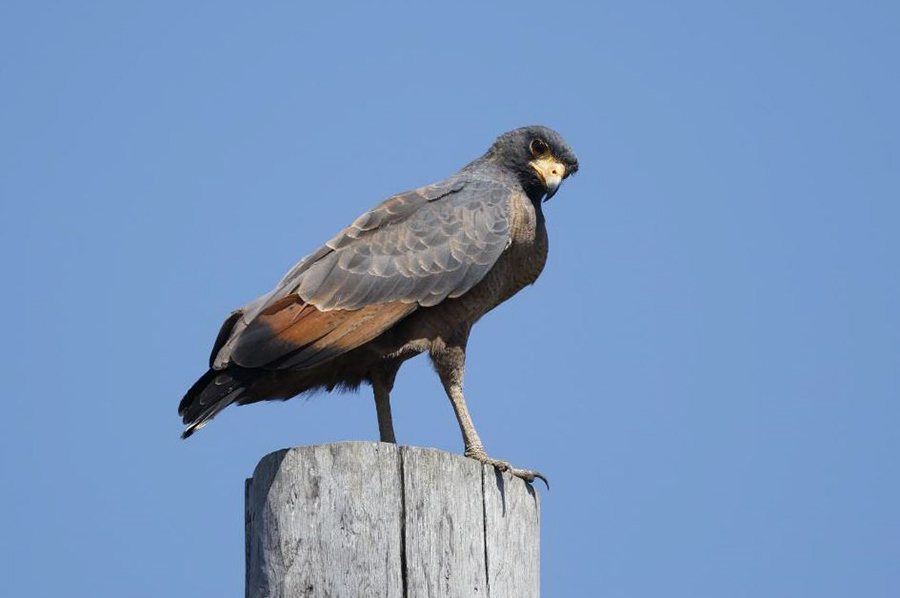
Rufous Crab Hawk (photo Sue Bryan).
We enjoyed the views of the Atlantic shores, with the mudflats and the mangroves giving way to the city – where modern buildings stand next to typical colonial architecture – in the background. We left this area to try for Mangrove Rail, which was unfortunately not around today, and hot weather soon started, without mercy. We then had a brilliant encounter with the localized Rufous Crab Hawk, an important bird in this part of the country. We also had nice views of Pearl Kite, as always, lovely to see through the scope. We then returned to our hotel for a rest during the heat of the day.
In the afternoon we had an incredible time in Guyana Botanical Gardens in Georgetown, starting with common species such as Ruddy Ground Dove, Smooth-billed Ani, Plumbeous Kite, Yellow-headed Caracara, Great and Lesser Kiskadees, Black-capped Donacobius, Palm and Blue-grey Tanagers, and the only Turquoise Tanager of the trip. Other species included Blue-black Grassquit, Wing-barred Seedeater, Red-legged Honeycreeper, Pale-breasted Thrush, Common Tody-Flycatcher, Rusty-margined Flycatcher, Cinereous Becard, Straight-billed Woodcreeper, Peregrine Falcon, Brown-throated Parakeet, Black-necked Aracari, Toco Toucan (the largest toucan in the world) and many Orange-winged Amazons. Red-shouldered Macaw produced great excitement, especially when enjoyed through the scope, and even though it took some time, we managed to find Festive Amazon, which we had sadly missed on our 2023 trip.
The gardens were very productive in the afternoon, revealing Straight-billed Woodcreeper, Grey Kingbird, Snail Kite and, of course, two of the main targets of the day, White-bellied Piculet and the most-wanted Blood-colored Woodpecker, which is restricted to the coast of Guyana and Surinam. With all these great sightings we returned to our hotel, after a very long day in the field. Here, we had some sightings of Guianan Brown Capuchin.
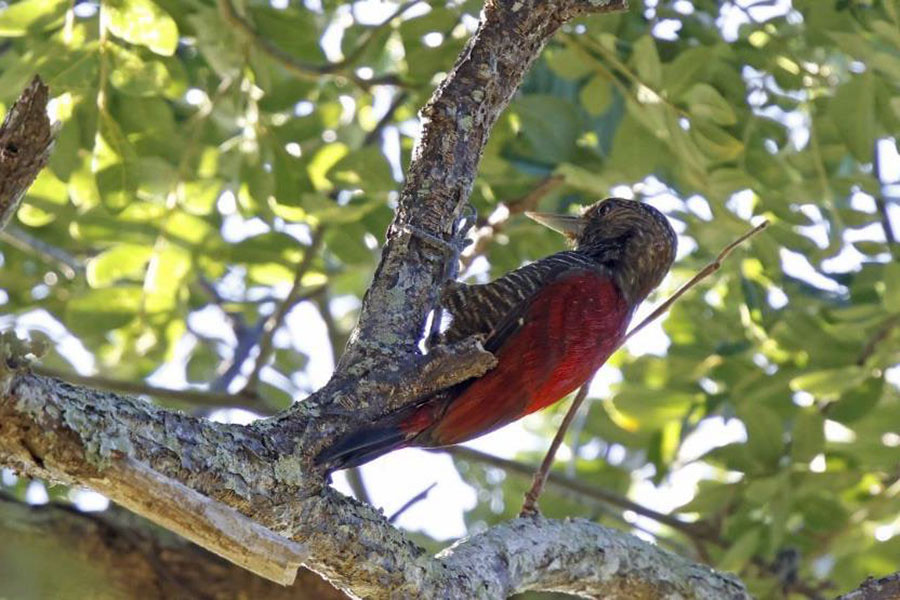
Blood-colored Woodpecker seen at the botanical garden (photo Sue Bryan).
Day 3, 23rd January 2024. Flight to Kaieteur Falls and Surama Eco-Lodge
We started the day with Plain-bellied Emerald in the lodge grounds before transferring to the domestic airport to catch our charter flight to Kaieteur Falls. After an easy flight, we landed at Kaieteur National Park and were fascinated by the incredible geography of this unique place, surrounded by table-like mountains – tepuis. We excitedly anticipated all the key localized species found only in the inaccessible Guyana highlands.
We started hiking to the first viewpoint, birding along the way and found Rufous-crowned Elaenia, Swallow and Silver-beaked Tanagers, Blue Dacnis, Green Honeycreeper, Tropical Kingbird, Cayenne Jay, Forest Elaenia and Black-tailed Tityra. Only a few of us got to glimpse the male Red-shouldered Tanager, which soon disappeared into the bushes, never to be seen again.
We arrived at the impressive waterfall viewpoint and, after taking photos and enjoying the incredible natural beauty, we managed to find an Orange-breasted Falcon hunting along the lowest parts of the waterfall. It was a stunning sighting of this rare and patchily distributed species. We also enjoyed views of White-tipped Swift and Cliff Flycatcher.
The final two sightings here included nice views of the handsome Guianan Cock-of-the-rock, which showed well, and Golden Frog, an Endangered Guyana endemic, with its distribution centered around Kaieteur Falls. This tiny frog is found only on the giant bromeliads of the genus Brocchinia,which are common in the area.
We then took the 30-minute flight to Surama Eco-Lodge, landed on the local airstrip and were picked up by our main driver for the rest of the trip, who transferred us to the lodge. After check-in we managed to do some birding in pleasant surroundings which provided species like Pale-vented Pigeon, Ruddy Ground Dove, Green Ibis, Savanna Hawk, Plumbeous Kite, Great Black Hawk, Neotropical Palm Swift, Blue-headed Parrot and Red-and-green Macaw, which always look spectacular flying above the vast tropical forest. Other birds included Great Potoo (at its day roost), Forest and Plain-crested Elaenias, Crested Oropendola, Swallow-winged Puffbird, Blue-grey and Palm Tanagers (nesting under the cabin rooms) and, before dusk, we had Lesser Nighthawk flying above the Surama Lodge clearing. After supper we went to bed in preparation for tomorrow’s forest interior birding.
Day 4, 24th January 2024. Full day at Surama Eco-Lodge
We started the day watching some open country species such as Scaled Pigeon and White-tipped Dove, before entering the forest and enjoying our first encounter with Great Tinamou, crossing the trail in front of us. We had a great morning, despite the dry conditions of the forest. We managed to find White-crowned Manakin, Green-backed Trogon, Guianan Trogon, Guianan Puffbird, Great Jacamar, Paradise Jacamar, Black Nunbird, Grey-headed Kite, Green Aracari, White-throated Toucan, Lineated and Cream-colored Woodpecker, Channel-billed Toucan, Golden-winged Parakeet and Red-throated Caracara.
We arrived in an area where army ant swarms are often found, and where we had an incredible encounter with two Rufous-winged Ground Cuckoos in 2023. We found the army ant swarm and found Rufous-throated Antbird, the iconic White-plumed Antbird, Plain-brown Woodcreeper, Black-chinned Antbird and, in the middle of a mixed feeding flock frenzy, John had a glimpse of the most-wanted Rufous-winged Ground Cuckoo, which sadly immediately disappeared behind a log. The ants retreated and the bird activity was over, nevertheless, we continued doing our best to find more species, always hoping to find the ground cuckoo once more. This may sound unrealistic, but it is possible in Guyana, the best place to see this species.
In the evening, we found more species, including Amazonian Barred Woodcreeper, Black-tailed Tityra, Ruddy-tailed Flycatcher, Yellow-bellied and Forest Elaenias, Piratic Flycatcher (near the oropendola nests), Green Oropendola, Red-rumped Cacique, Scarlet Macaw, White-throated Toucan, Orange-winged Amazon, Brown-throated Parakeet, a female Tufted Coquette, and Buff-throated Woodcreeper. The grassland around the lodge provided nice views of Wedge-tailed Grass Finch.
In the evening, we tried for Spectacled Owl and Tawny-bellied Screech Owl, both of which showed well. Additionally, we heard Crested Owl and Amazonian Pygmy Owl.
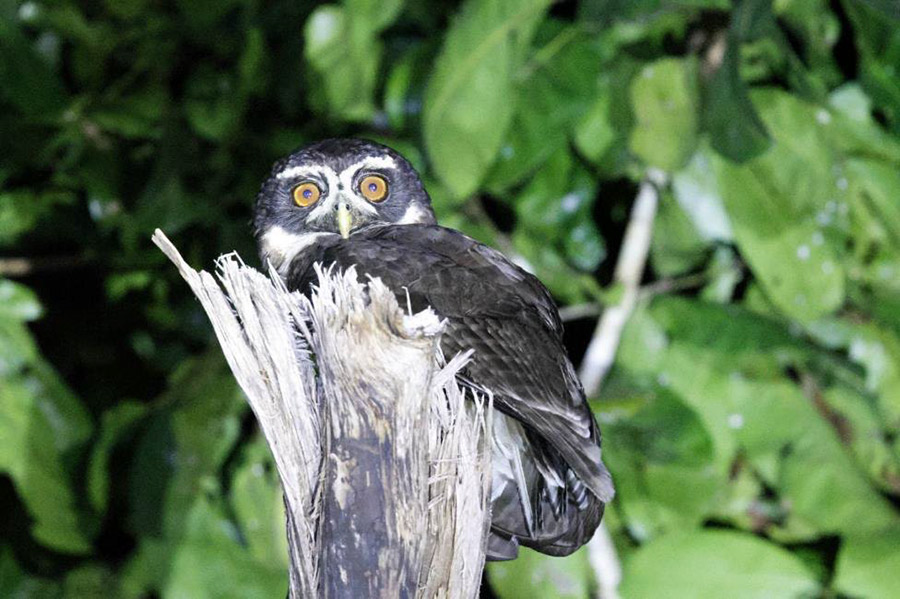
Spectacled Owl at Surama Eco-Lodge (photo Sue Bryan).
Day 5, 25th January 2024. Birding around Surama and transfer to Iwokrama Lodge
We started the day by visiting a forested swampy area where the shy and secretive Zigzag Heron had been seen recently. We arrived at the site as quietly as possible and, after some effort and patience, we managed to get splendid views of this nocturnal and poorly known species, for everybody’s enjoyment.
After this incredible sighting, we returned to the lodge for breakfast. We then explored some forest trails around Surama, before leaving for Iwokrama Lodge. We had a great morning finding species such as Painted Parakeet, Blue-and-yellow and Red-and-green Macaws, Epaulet Oriole, Helmeted Pygmy Tyrant, and Caica and Blue-headed Parrots giving fly-by views. After some forest walking, we managed to find another army ant swarm and decided to try for Rufous-winged Ground Cuckoo. It didn’t take long before we heard the bird approaching, with the characteristic bill-clapping sound, giving everyone goosebumps. Sadly, the individual was very cautious and proved secretive, keeping its distance between foliage and forest floor trunks. Nevertheless, most of us managed to get full views, or at least the full head, before it became aware of us and disappeared, not to be seen again on this tour. Other interesting species included Black-chinned Antbird, Wedge-billed Woodcreeper, Northern Slaty and Cinereous Antshrikes, Rufous-bellied Antwren, and Grey and Ferruginous-backed Antbirds.
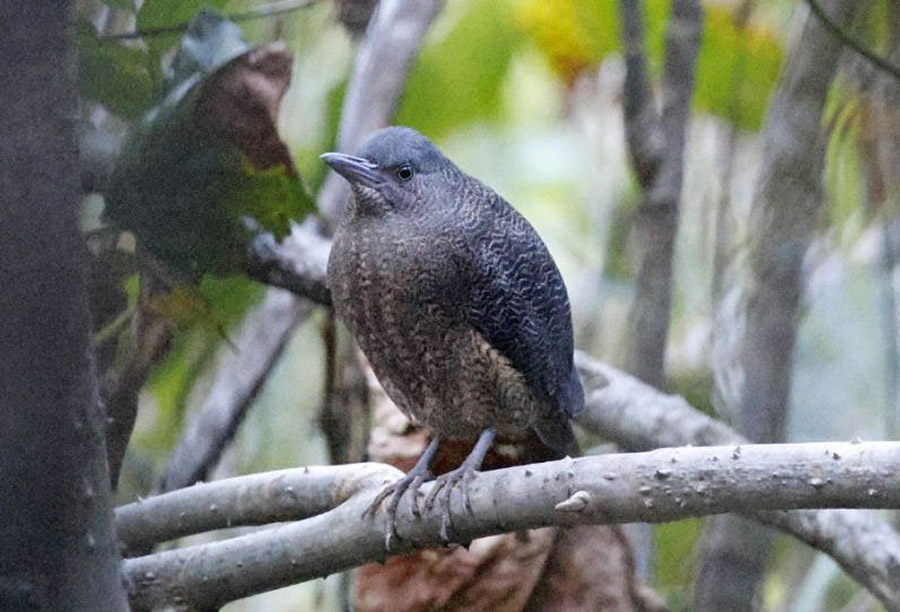
The secretive Zigzag Heron was a nice surprise on our Guyana birding trip (photo Sue Bryan).
We left the general area and drove towards our next destination, Iwokrama River Lodge. As I looked at the progress of the construction of the road that will join Lethan, on the Brazilian border, with Georgetown, I wondered how this will affect the birds and wildlife that inhabit this undisturbed forest. Sadly, the amount of traffic has already increased significantly compared to last year’s tour. The good thing is that the road is closed at 5pm every afternoon, and that might help alleviate nocturnal species being disturbed and becoming roadkill.
Along the drive we saw Greater Yellow-headed Vulture, Swallow-tailed Kite, Crested Oropendola and Rufescent Tiger Heron. We arrived at Iwokrama for lunch and enjoyed the beautiful setting next to the Essequibo River, a nice change from all the other lodges, which are surrounded by forest or haciendas. We spent the afternoon birding around the lodge, finding Chestnut-bellied Seedeater, Rufous-throated Sapphire, Fasciated Antshrike, Guianan Streaked Antwren, and Green Honeycreeper, and we scored with the most-wanted Grey-rumped Trumpeter. Trumpeters are part of a family containing only three species in the entire world.
Day 6, 26th January 2024. Turtle Mountain and Boat River
Today we planned to explore the lower and mid portions of Turtle Mountain, for which we split the group into two boats for a 20-minute boat ride and, after reaching the base of the trail, we started the hike together. Activity was very low, starting with views of Spix’s Guan, Guianan Trogon, Red-necked Woodpecker, Black Caracara, Grey-rumped Swift, Bat Falcon, Plumbeous Kite, Black Nunbird, Reddish Hermit, Blue-headed Parrot, Blue-and-yellow Macaw, and other usual suspects. We found a large army ant swarm, but with no birds attending, eventually we encountered a large group of White-lipped Peccaries which gave us the full performance. This was one of our quietest mornings in Guyana. Hot and dry, we returned to the lodge to rest and take another boat trip in the afternoon.
The boat trip was very nice, with a welcome breeze and aquatic species such as Black-collared Swallow, Muscovy Duck, Pied Plover, Spotted Sandpiper, Southern Lapwing, Anhinga, Large-billed and Yellow-billed Terns, Neotropic Cormorant, Cocoi Heron, Green Ibis, White-winged Swallow, Amazon and Green Kingfishers and, before dusk, Ladder-tailed Nightjar (male and female) and Boat-billed Heron.
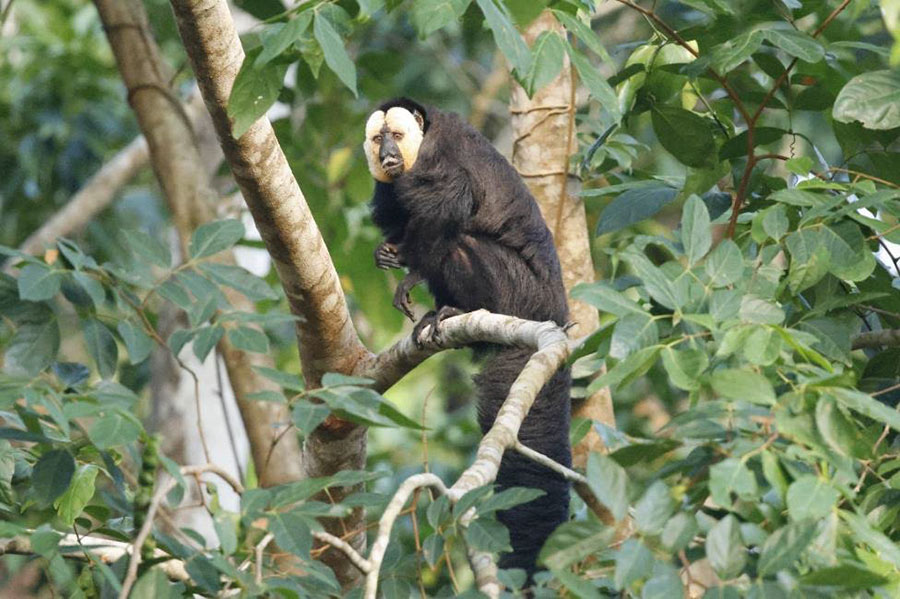
We had a great encounter with the uncommon White-faced Saki at Iwokrama River Lodge (photo Sue Bryan).
Day 7, 27th January 2024. Birding en route to Atta Lodge
This was our last day around Iwokrama, and as we walked around the lodge clearing, we found the usual suspects, along with a Ringed Woodpecker playing hide and seek with us. On our way out we found the amazing White-faced Saki (also called Guianan Saki), which is restricted to northeast South America.
Birding the road to Atta Lodge provided great birds, including Spangled Cotinga, Bronzy Jacamar, Crimson-crested Woodpecker, Sunbittern, Capped Heron, King Vulture, Grey-lined Hawk, Ringed Kingfisher and Swallow-tailed Kite, with the other amazing sighting being the stunning Pompadour Cotinga (male and female) feeding in the same tree as Spangled Cotinga and Green Aracari.
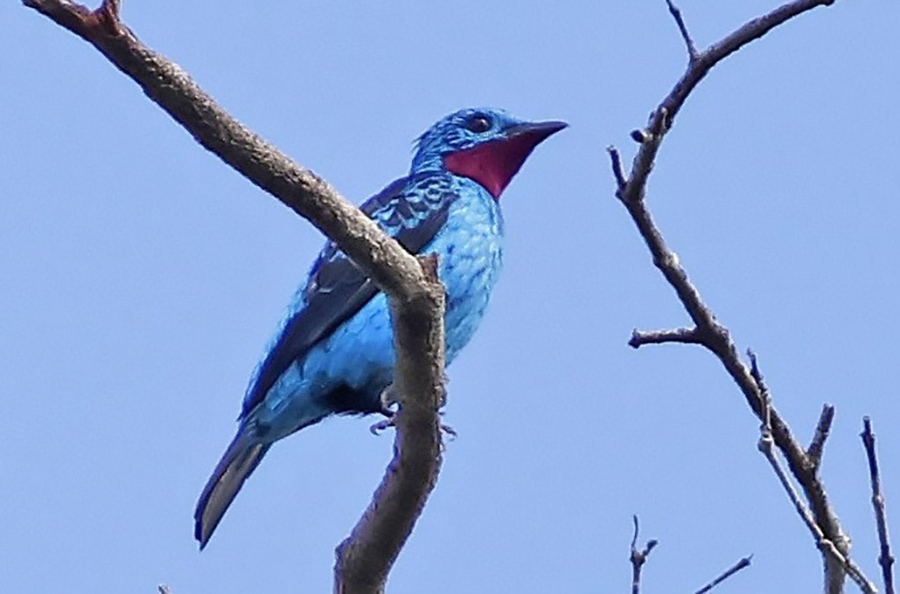
Spangled Cotinga along the Atta Road (photo Sue Bryan).
The rest of the afternoon was quiet. We, however, found Grey-breasted Sabrewing, Long-tailed Hermit, Fork-tailed Woodnymph, Black-necked Aracari, Green Oropendola, Channel-billed Toucan, Red-necked Woodpecker, Red-throated Caracara, Golden-winged Parakeet, Blue-cheeked Parrot, Southern Mealy Amazon, Purple-throated Fruitcrow, the localized Black-faced Hawk and the diminutive Golden-headed Manakin, which was found on one of the white sand forest trails, where we also saw Bronzy Jacamar.
When we reached Atta lodge, we were given the bad news that the once-reliable Crimson Fruitcrow had not been seen for several days. Despite considerable effort we could not find any during our stay or along the drive out of the rainforest which turned out to be the only Guyana special that we were unable to find on the trip. In the evening we tried for White-winged Potoo, which came into view, as did Short-tailed Nighthawk, but we only heard the scarcer Common Potoo.
Day 8, 28th January 2024. Birding Atta Canopy Walkway
We had a predawn start under the spectacular stars, with the Pleidaes visible next to Orion, and the peaceful Atta rainforest embracing us, as we craved a cup of coffee. There weren’t any owls calling around the clearing this morning, except for the very distant call of Amazonian Pygmy Owl, which proved difficult to see this year. The sounds of the rainforest changed, from the pygmy owl to howler monkeys, then parrots and macaws, merging into a vast chorus of several species of birds, becoming a single sound that marked the beginning of a new morning. We were looking forward to visiting the famous Canopy Walkway at Atta.
Hoping for the best, we hiked up the trail to the canopy, finding no activity in the understory. We crossed the suspension bridges and reached the platforms, where we had our first encounter with the widespread Guianan Weeper Capuchin. One of the main targets, Guianan Toucanet (a localized Selenidera from northern South America) was quickly spotted. In addition, we had Black-eared Fairy, which is regularly seen feeding in the tree canopy. We also saw Green-backed and Guianan Trogons, Guianan Puffbird, Black Nunbird, Blue-cheeked Parrot, Red-and-green Macaw, Black-spotted Barbet and a female Pompadour Cotinga, but still no Crimson Fruitcrow! Other common species encountered included Southern Mealy Amazon, and Spot-tailed Antwren, which is a canopy special.
On one of the trails, we were delighted to have a long-awaited encounter with the distinctive Capuchinbird, not only seeing the bird but hearing its unique display call. Later in the trip we had another encounter with this species, but it was high in the trees and difficult to photograph.
We decided to go back to the lodge for breakfast and to explore the lodge grounds and the road to Atta. On the way back to the lodge we saw Wedge-billed Woodcreeper, Screaming Piha and the most-wanted Red-and-black Grosbeak, a fantastic encounter! After breakfast, which was served by the lodge’s friendly staff, we went to explore the entrance road. Again, no sign of the fruitcrow!
Excitingly, we saw a Green Anaconda, well hidden in a flooded area, not far away from the road. This was the second year that I had encountered Green Anaconda in this area! We then had massive flocks of Band-rumped and Grey-rumped Swifts, as well as Plumbeous Pigeon, King Vulture, Paradise and Green-tailed Jacamars, Lineated and Ringed Woodpeckers, Yellow-bellied Elaenia, Yellow-throated Flycatcher, Capped Heron and Green Ibis.
In the afternoon we tried for Crimson Topaz along the road, in areas near streams, and searched in every possible place from the moment we arrived at Atta. Our strategy was to play the call and wait for a bit, if it did not show, we would leave and continue birding. We couldn’t even catch a glimpse of it, until the final evening at Atta. The bird responded and landed in a tall tree but took off again so fast that we barely saw the bird in silhouette. Amazingly, Sue managed a photo, in which we could see that it was a male.
Later we explored some of the white sand forest trails that go off from the main road and, after some hard work, we eventually saw one of the main targets in this habitat, the shy Black Manakin. We continued birding along the road and suddenly detected a family of Little Chachalacas (sometimes called Variable Chachalaca by other authorities) crossing the road.
We waited until dusk to try for Black-banded Owl, which came in to the recording and showed nicely, but kept high in the subcanopy where we managed to get great scope views. We also found a Kinkajou watching us from the tops of the Cecropia trees. After a long day, we retreated to the lodge for supper and a good night’s sleep.
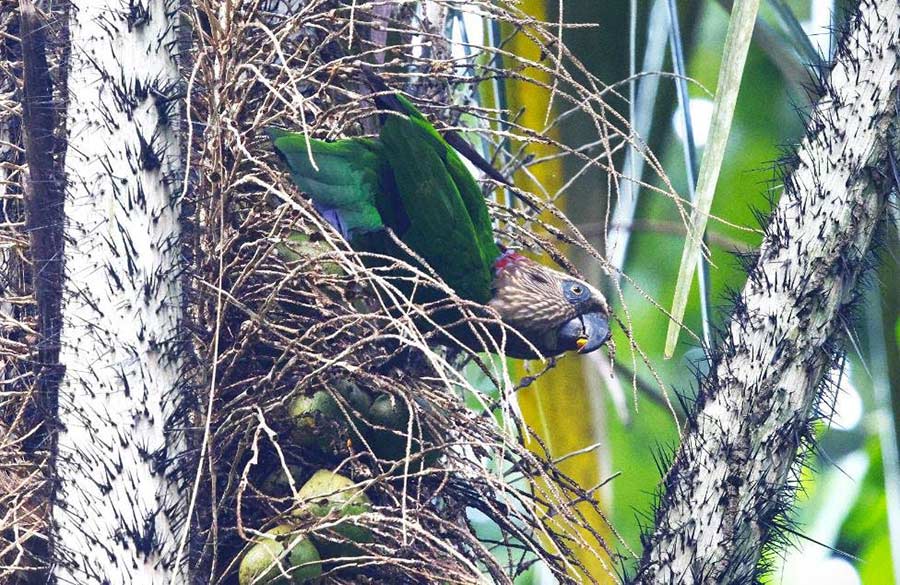
Red-fan Parrots showed very well on our last morning at Atta (photo Sue Bryan).
Day 9, 29th January 2024. Last morning at Atta and transfer to Rock View
We had planned to maximize the first hours of the morning around Atta, before leaving the lodge and the rainforest. We scanned the lodge clearing, looking for Crimson Fruitcrow, which sadly did not show. We heard Guianan Warbling Antbird calling around the clearing, but only a few participants glimpsed it. We hurried from the spot when we heard Red-fan Parrot vocalizing. We found the tree where they were nesting and later had the pleasure of seeing this fantastic species, feeding low on one of the fruiting palm trees around the lodge clearing! This was one of the most-wanted birds for both our Johns and we happily feasted our eyes on these attractive parrots, before they flew away from the lodge.
We continued exploring one of the lodge trails and found the Guianan Red Cotinga, which is one of the most-wanted species in Guyana. They quickly moved under the canopy and were difficult to photograph, so we had to be content just watching this gorgeous bird.
We left the lodge and returned to the Crimson Topaz spot, but there was nobody home today. We continued birding along the road, heading back to Surama Lodge. On the way, we saw Dusky Purpletuft and the only Marail Guan of the trip.
We arrived at the junction with Surama Lodge, where we had an amazing time. We spotted a Black Hawk-Eagle flying high and calling, which flew in closer above the track a couple of times, allowing us to see it in detail. Then we were told that we were close to an area where Ornate Hawk-Eagle had been seen recently and soon we heard the bird calling which we managed to see shortly after. It flew about and perched briefly on one side of the trail, allowing us all to see it well, unfortunately, some branches in front ruined the possibility of good photos.
Ironically, after this hawk-eagle madness, we found a Brown-throated Sloth very close to the trail. There were no new birds after this, except for some more classic sightings, including Greater Yellow-headed Vulture, Swallow-tailed Kite, Yellow-rumped and Red-rumped Caciques, Yellow-headed Caracara, Scaled Pigeon, and Great Kiskadee.
We ate a delicious lunch at the Surama community and then headed to Rock View Lodge, arriving in the heat of the early afternoon. We agreed to rest and then met again at 3 pm to explore the vicinity.
We arrived at a mix of grasslands and wetlands and had a productive couple of hours birding, finding Fork-tailed Flycatcher, Crested Bobwhite, Burnished-buff Tanager, Grey, Ruddy-breasted and Wing-barred Seedeaters, Red-breasted Blackbird, Yellow Oriole, Orange-backed Troupial, Finsch’s Euphonia, Black-capped Donacobius, Barn Swallow, Boat-billed Flycatcher, Lesser Kiskadee, Short-crested Flycatcher, White-headed Marsh Tyrant, Pied Water-Tyrant, Yellow-chinned Spinetail, Northern Mouse-colored Tyrannulet, American Kestrel, Black-collared Hawk, Cocoi Heron, Jabiru, Spotted and Solitary Sandpipers, Common Ground Dove, Green-tailed Goldenthroat and Long-billed Starthroat.
We put a great effort into finding White-naped Xenopsaris, which showed very well for the whole group. Other birds seen at this location included Little Blue Heron, Great and Snowy Egrets, Laughing Falcon, Ringed, Amazon and Green Kingfishers, Wattled Jacana, Green Ibis and Striated Heron.
Just before dusk, we were ecstatic when we saw a couple of Least Nighthawks flying above the fields, still with enough light to see their markings and patterns.
Day 10, 30th January 2024. Essequibo River and birding around Rock View
Unfortunately, several of us had battled to sleep the previous night, due to the intense heat and the fans not being strong enough. However, after an early start, a cup of coffee did wonders to raise our spirits for a day full of adventure. We had a scheduled boat ride on the Rupununi River to look for water species, including the Crestless Curassow.
It didn’t start well as soon after we arrived at the river it started raining, which is not fun on a boat trip. We had two boats and went on the river, hoping the weather would change. It rained, then stopped, then drizzled, then stopped again. With this weather there were not many birds, or at least nothing we had not seen on previous boat trips. The birds we saw this morning included Pale-vented Pigeon, Muscovy Duck, Smooth-billed Ani, Grey-rumped Swift, Limpkin, Large-billed and Yellow-billed Terns, Black Skimmer, Jabiru, Wood Stork, Anhinga, Capped Heron, Black-collared Hawk and Osprey. As we rounded a bend in the river, we suddenly spotted a pair of Crestless Curassow. They were not walking along the sandbars but sitting on a dead tree on the riverbank. We barely saw them before they disappeared, most likely scared by the boats, and sadly not all participants saw them.
We landed on the mainland and tried for some gallery forest birds, such as Black-crested Antshrike, which showed nicely, Coraya Wren, Cinnamon Atilla, Red-capped Cardinal and others. We returned to Rock View in the heat of the day, had lunch and enjoyed some relaxed birding around the property. The afternoon’s easy birding yielded Pale-breasted Thrush, Burnished-buff Tanager and other common species, including Blue-grey and Palm Tanagers. We also took the opportunity to enjoy coffee and cookies, and some cold drinks as well.
Day 11, 31st January 2024. Sun Parakeet and transfer to Manari
Today we took a special trip to explore the deciduous habitats near the Guyana-Brazil border, to look for the endangered Sun Parakeet, one of the targets of this second part of the tour. Sun Parakeets have been caught at a rate of 800,000 per year for the pet trade and are today poorly known in the wild. They have probably been eradicated from French Guyana and are only found in this small portion of Guyana and adjacent Brazil. We arrived and got excited every time we saw a flock of Brown-throated Parakeets. It took a while, but we eventually saw two pairs of Sun Parakeets flying by and landing below the tree tops, before they left to likely join a larger flock – it is usual for flocks to contain around 100 individuals. On the previous year’s tour, we saw more individuals lower down in the trees. We, however, had great scope views, but photography was challenging.
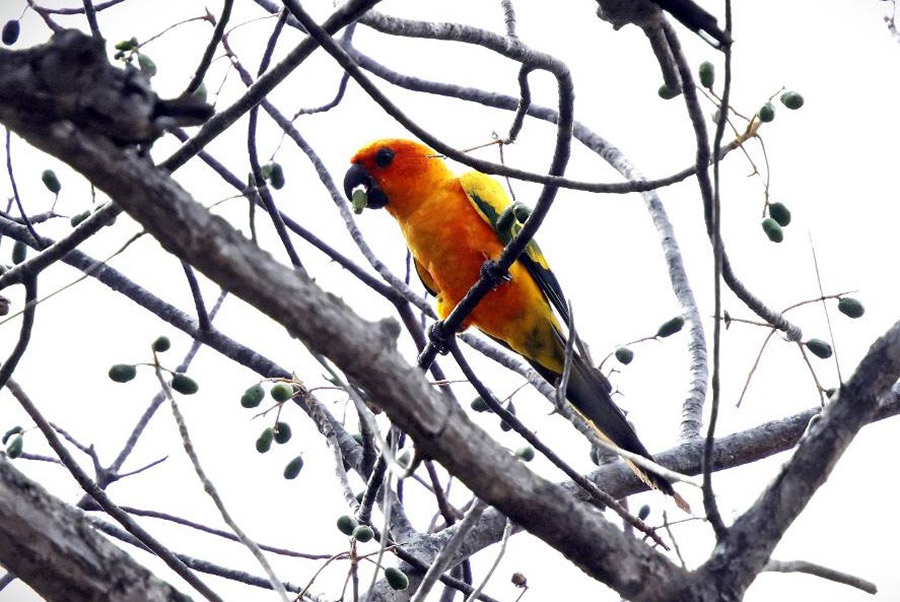
Sun Parakeet was the star in the Manari area (photo Sue Bryan).
In addition, we managed to find Double-striped Thick-knee, Blue-tailed Emerald, Glittering-throated Emerald, Buff-necked Ibis, Common Ground Dove, Crested Bobwhite, Lesser Yellow-headed Vulture, Ferruginous Pygmy Owl, White-barred Piculet, Southern White-fringed Antwren, Streak-headed Woodcreeper, Pale-legged Hornero, Pale-eyed Pygmy Tyrant, Southern Beardless Tyrannulet, Brown-crested Flycatcher, Yellow-bellied Elaenia and Ashy-headed Greenlet.
We then continued our drive towards Manari, our base for the next two nights. Along the way we spotted Wedge-tailed Grass Finch, Grassland Sparrow, Yellowish Pipit, Eastern Meadowlark and Grey Seedeater. We made a stop to look for another grassland target in the Rupununi area, the Crested Doradito. We persevered, in the intense heat of the day, searching for this little skulker. Thankfully, we were fortunate to find an individual, as the habitat was untouched in this particular area, whilst other suitable and known habitat had been burned by fires during this unusually dry season.
In the afternoon we hung around the hotel grounds, finding not only some common species, but also our first records of Bicolored Wren, American Yellow Warbler, Burnished-buff Tanager, Olive-grey Saltator, Yellow-bellied and Lesser Elaenias and Common Tody-Flycatcher.
Manari Ranch was very hot, although the food was good, and there was lime and watermelon juice continually available. We also took advantage of the “few quiet moments of the trip” to relax and enjoy other refreshments – at sundown some participants discovered that the Guyanese rum was particularly good.
We retired early to our rooms, immediately after dinner, since a 4 am start was awaiting us the next day. The reason for such an early start was the 4×4 drive to access some Red Siskin habitat, one of the few remaining patches in the world, with arguably the largest known population.
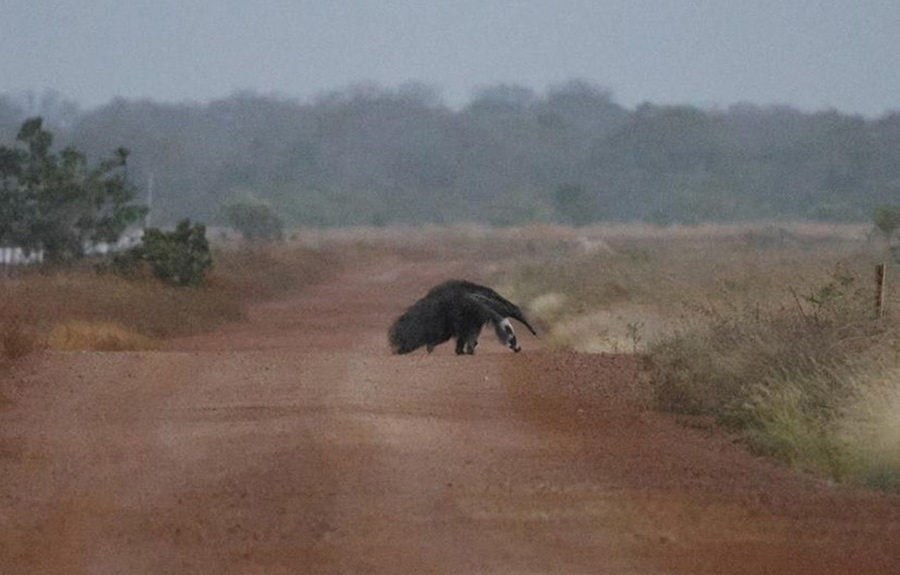
We had a great encounter with a Giant Anteater in the Rupununi savannas (photo Sue Bryan).
Day 12, 1st February 2024. Red Siskin 4×4 vehicle drive and back to Manari
We had a super-early, super-excited start today. After some good, strong coffee, we climbed into the 4×4 vehicles required to reach the habitat of the ultra-rare Red Siskin. We split the group into two vehicles for comfort’s sake and headed out at dawn’s first light. On the main road we had an incredible encounter with a Giant Anteater and saw two more individuals nearby. After a long drive past rivers, streams and amazing scenery, we reached the habitat and, not long after we arrived, we spotted a small flock of Red Siskins, with the most-wanted male sitting out in the open for us. It was brilliant.
Our local guide was Leeroy who is the representative from the local community, and oversees the project for the conservation of Red Siskin and the development of ecotourism in the area. They have done excellent work here and deserve all possible support from those who can assist in improving facilities for tourists to help protect the habitat of the Red Siskin.
No longer under pressure to find the siskin, we wondered what we should do next. We decided to eat our packed breakfast under a roof, on a nice table recently built for visitors. As we were enjoying breakfast, we suddenly saw the same family party flying by again.
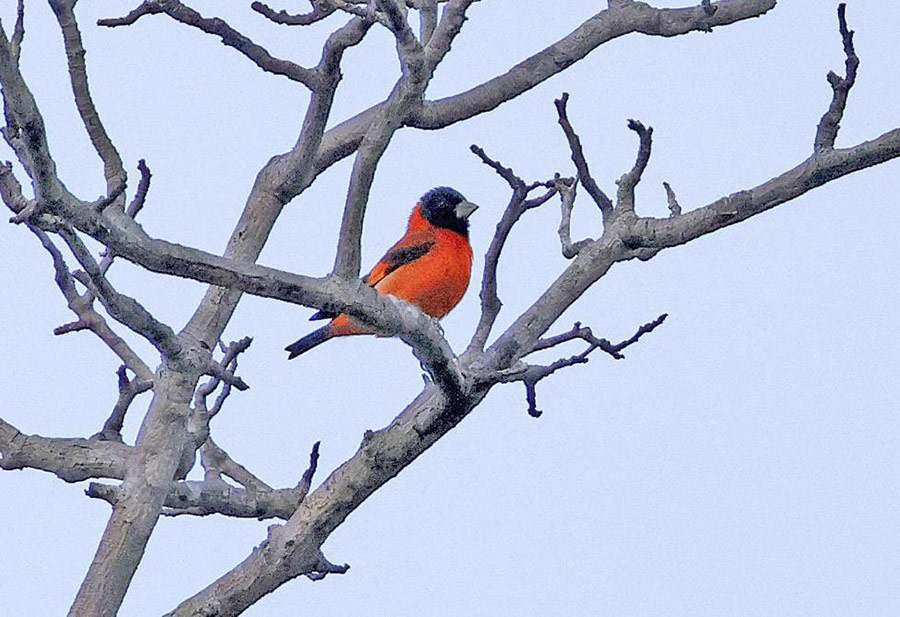
We had amazing views of the Endangered Red Siskin on our Guyana trip (photo Sue Bryan).
We birded the surroundings, finding pretty much the same common species, so we left and spent more time on the habitats and ponds on the way back. We did well, finding Hooded Tanager, Spotted Puffbird, Hepatic Tanager, Orange-backed Troupial, Grassland Sparrow, Cayenne Jay, Black-crested Antshrike, Lesser Yellow-headed Vulture, Buff-necked Ibis, Common Ground Dove and Crested Bobwhite. An interesting observation through the scope was a juvenile King Vulture. We then encountered Maguari Stork, which was new for the trip, and a superb find in the form of Pinnated Bittern, well camouflaged in the pond’s reeds. Feeling successful, we headed to the community where we had a tasty lunch and, despite the heat of the day, continued towards Manari Ranch.
On the way, we stopped to look for another localized species. We were worried because we saw so many patches of grassland and bushes that had been burned, nevertheless, we did find a couple Bearded Tachuris, which were the cherry on top for the day. We arrived at Manari Ranch and spent the afternoon resting, in preparation for our final day of birding in the area tomorrow. Sadly, our trip was soon coming to an end.
Day 13, 2nd February 2024. Rio Branco and Silver-throated Spinetail, and flight to Georgetown
We had another early start (although not as early as the previous day) and went to explore a mix of habitats between gallery forest and savanna. The main targets were two Critically Endangered species, Rio Branco Antbird and Hoary-throated Spinetail. On the way, we spotted Burrowing Owl, Savanna Hawk, Long-winged Harrier, Common and Ruddy Ground Doves and Buff-necked Ibis.
We started birding in the gallery forest and soon had great views of Rio Branco Antbird. The spinetail was tricky though. We found a pair that were showing fleetingly and were very shy, but we eventually managed fine views of Hoary-throated Spinetail. We also found Spot-breasted and Little Woodpeckers, Brown-crested Flycatcher, Boat-billed Flycatcher, Ashy-headed Greenlet, Northern Mouse-colored Tyrannulet, Glittering-throated Emerald, and Yellow-bellied Elaenia while Rufous-tailed Jacamar was heard only. We tried for Flavescent Warbler, but we could not even hear it today. We started the walk back to the vehicles along which John and Sue saw a Capybara near the river.
We returned to Manari Ranch for lunch, to pack our luggage and transfer to Letham for the commercial flight to Georgetown. We said goodbye to our incredible land crew, especially Gary, and flew to Georgetown. We transferred to Cara Lodge, ate our last meal together and prepared for tomorrow’s early start to be at the international airport three hours before our flight.
I felt a warm and pleasant satisfaction from having led a great group of people, all of whom had vast outdoor experience and who were so enthusiastic about birds and wildlife. The weather had been dry, but we nevertheless got most of our targets and special birds, except the fruitcrow! Everyone was happy, and we had a good reason to come back to Guyana – to tick the fruitcrow!
Thank you very much to the whole group, you were amazing!
Day 14, 3rd February 2024. Transfer to the airport and flight home
The group transferred at different times to the respective airports to connect with their flights home.
Bird List – Following IOC (13.2)
Birds ‘heard only’ are marked with (H) after the common name, all other species were seen.
The following notation after species names is used to show conservation status following BirdLife International: VU = Vulnerable.
| Common Name | Scientific Name |
| Tinamous (Tinamidae) | |
| Great Tinamou | Tinamus major |
| Cinereous Tinamou (H) | Crypturellus cinereus |
| Red-legged Tinamou (H) | Crypturellus erythropus |
| Ducks, Geese, Swans (Anatidae) | |
| Muscovy Duck | Cairina moschata |
| Chachalacas, Curassows, Guans (Cracidae) | |
| Little Chachalaca | Ortalis motmot |
| Marail Guan | Penelope marail |
| Spix’s Guan | Penelope jacquacu |
| Crestless Curassow | Mitu tomentosum |
| Black Curassow – VU | Crax alector |
| New World Quail (Odontophoridae) | |
| Crested Bobwhite | Colinus cristatus |
| Marbled Wood Quail (H) | Odontophorus gujanensis |
| Nightjars (Caprimulgidae) | |
| Nacunda Nighthawk | Chordeiles nacunda |
| Least Nighthawk | Chordeiles pusillus |
| Lesser Nighthawk | Chordeiles acutipennis |
| Short-tailed Nighthawk | Lurocalis semitorquatus |
| Pauraque | Nyctidromus albicollis |
| White-tailed Nightjar | Hydropsalis cayennensis |
| Ladder-tailed Nightjar | Hydropsalis climacocerca |
| Potoos (Nyctibiidae) | |
| Great Potoo | Nyctibius grandis |
| Common Potoo (H) | Nyctibius griseus |
| White-winged Potoo | Nyctibius leucopterus |
| Swifts (Apodidae) | |
| White-collared Swift | Streptoprocne zonaris |
| Grey-rumped Swift | Chaetura cinereiventris |
| Band-rumped Swift | Chaetura spinicaudus |
| White-tipped Swift | Aeronautes montivagus |
| Neotropical Palm Swift | Tachornis squamata |
| Hummingbirds (Trochilidae) | |
| Crimson Topaz | Topaza pella |
| Reddish Hermit | Phaethornis ruber |
| Long-tailed Hermit | Phaethornis superciliosus |
| Black-eared Fairy | Heliothryx auritus |
| Green-tailed Goldenthroat | Polytmus theresiae |
| Black-throated Mango | Anthracothorax nigricollis |
| Tufted Coquette | Lophornis ornatus |
| Long-billed Starthroat | Heliomaster longirostris |
| Blue-tailed Emerald | Chlorostilbon mellisugus |
| Grey-breasted Sabrewing | Campylopterus largipennis |
| Fork-tailed Woodnymph | Thalurania furcata |
| Plain-bellied Emerald | Chrysuronia leucogaster |
| Glittering-throated Emerald | Chionomesa fimbriata |
| Rufous-throated Sapphire | Hylocharis sapphirina |
| Cuckoos (Cuculidae) | |
| Smooth-billed Ani | Crotophaga ani |
| Striped Cuckoo (H) | Tapera naevia |
| Rufous-winged Ground Cuckoo | Neomorphus rufipennis |
| Little Cuckoo | Coccycua minuta |
| Squirrel Cuckoo | Piaya cayana |
| Pigeons, Doves (Columbidae) | |
| Rock Dove (Introduced) | Columba livia |
| Scaled Pigeon | Patagioenas speciosa |
| Pale-vented Pigeon | Patagioenas cayennensis |
| Plumbeous Pigeon | Patagioenas plúmbea |
| Ruddy Pigeon – VU | Patagioenas subvinacea |
| Common Ground Dove | Columbina passerina |
| Plain-breasted Ground Dove | Columbina minuta |
| Ruddy Ground Dove | Columbina talpacoti |
| Blue Ground Dove | Claravis pretiosa |
| White-tipped Dove | Leptotila verreauxi |
| Eared Dove | Zenaida auriculata |
| Rails, Crakes & Coots (Rallidae) | |
| Ash-throated Crake (H) | Mustelirallus albicollis |
| Trumpeters (Psophiidae) | |
| Grey-winged Trumpeter | Psophia crepitans |
| Limpkin (Aramidae) | |
| Limpkin | Aramus guarauna |
| Stone-curlews, Thick-knees (Burhinidae) | |
| Double-striped Thick-knee | Burhinus bistriatus |
| Plovers (Charadriidae) | |
| Southern Lapwing | Vanellus chilensis |
| Semipalmated Plover | Charadrius semipalmatus |
| Pied Plover | Hoploxypterus cayanus |
| Jacanas (Jacanidae) | |
| Wattled Jacana | Jacana jacana |
| Sandpipers, Snipes (Scolopacidae) | |
| Hudsonian Whimbrel | Numenius hudsonicus |
| Pectoral Sandpiper | Calidris melanotos |
| Spotted Sandpiper | Actitis macularius |
| Solitary Sandpiper | Tringa solitaria |
| Lesser Yellowlegs | Tringa flavipes |
| Willet | Tringa semipalmata |
| Greater Yellowlegs | Tringa melanoleuca |
| Gulls, Terns, Skimmers (Laridae) | |
| Black Skimmer | Rynchops niger |
| Yellow-billed Tern | Sternula superciliaris |
| Royal Tern | Thalasseus maximus |
| Large-billed Tern | Phaetusa simplex |
| Sunbittern (Eurypygidae) | |
| Sunbittern | Eurypyga helias |
| Storks (Ciconiidae) | |
| Wood Stork | Mycteria americana |
| Maguari Stork | Ciconia maguari |
| Jabiru | Jabiru mycteria |
| Anhingas, Darters (Anhingidae) | |
| Anhinga | Anhinga anhinga |
| Cormorants, Shags (Phalacrocoracidae) | |
| Neotropic Comorant | Nannopterum brasilianum |
| Ibises, Spoonbills (Threskiornithidae) | |
| Buff-necked Ibis | Theristicus caudatus |
| Green Ibis | Mesembrinibis cayennensis |
| Scarlet Ibis | Eudocimus ruber |
| Herons, Bitterns (Ardeidae) | |
| Rufescent Tiger Heron | Tigrisoma lineatum |
| Boat-billed Heron | Cochlearius cochlearius |
| Zigzag Heron | Zebrilus undulatus |
| Pinnated Bittern | Botaurus pinnatus |
| Black-crowned Night Heron | Nycticorax nycticorax |
| Yellow-crowned Night Heron | Nyctanassa violácea |
| Striated Heron | Butorides striata |
| Western Cattle Egret | Bubulcus ibis |
| Cocoi Heron | Ardea cocoi |
| Great Egret | Ardea alba |
| Capped Heron | Pilherodius pileatus |
| Tricolored Heron | Egretta tricolor |
| Little Blue Heron | Egretta caerulea |
| Snowy Egret | Egretta thula |
| Pelicans (Pelecanidae) | |
| Brown Pelican | Pelecanus occidentalis |
| Hoatzin (Opisthocomidae) | |
| Hoatzin | Opisthocomus hoazin |
| New World Vultures (Cathartidae) | |
| King Vulture | Sarcoramphus papa |
| Black Vulture | Coragyps atratus |
| Turkey Vulture | Cathartes aura |
| Lesser Yellow-headed Vulture | Cathartes burrovianus |
| Greater Yellow-headed Vulture | Cathartes melambrotus |
| Ospreys (Pandionidae) | |
| Osprey | Pandion haliaetus |
| Kites, Hawks, Eagles (Accipitridae) | |
| White-tailed Kite | Elanus leucurus |
| Pearl Kite | Gampsonyx swainsonii |
| Grey-headed Kite | Leptodon cayanensis |
| Swallow-tailed Kite | Elanoides forficatus |
| Black Hawk-Eagle | Spizaetus tyrannus |
| Black-and-white Hawk-Eagle | Spizaetus melanoleucus |
| Ornate Hawk-Eagle | Spizaetus ornatus |
| Long-winged Harrier | Circus buffoni |
| Plumbeous Kite | Ictinia plúmbea |
| Black-collared Hawk | Busarellus nigricollis |
| Snail Kite | Rostrhamus sociabilis |
| Rufous Crab Hawk | Buteogallus aequinoctialis |
| Savanna Hawk | Buteogallus meridionalis |
| Great Black Hawk | Buteogallus urubitinga |
| Roadside Hawk | Rupornis magnirostris |
| White-tailed Hawk | Geranoaetus albicaudatus |
| Black-faced Hawk | Leucopternis melanops |
| Grey-lined Hawk | Buteo nitidus |
| Short-tailed Hawk | Buteo brachyurus |
| Zone-tailed Hawk | Buteo albonotatus |
| Owls (Strigidae) | |
| Burrowing Owl | Athene cunicularia |
| Amazonian Pygmy Owl (H) | Glaucidium hardyi |
| Ferruginous Pygmy Owl | Glaucidium brasilianum |
| Tawny-bellied Screech Owl | Megascops watsonii |
| Spectacled Owl | Pulsatrix perspicillata |
| Crested Owl (H) | Lophostrix cristata |
| Black-banded Owl | Strix huhula |
| Trogons (Trogonidae) | |
| Green-backed Trogon | Trogon viridis |
| Guianan Trogon | Trogon violaceus |
| Kingfishers (Alcedinidae) | |
| Amazon Kingfisher | Chloroceryle amazona |
| American Pygmy Kingfisher | Chloroceryle aenea |
| Green Kingfisher | Chloroceryle americana |
| Green-and-rufous Kingfisher | Chloroceryle inda |
| Ringed Kingfisher | Megaceryle torquata |
| Jacamars (Galbulidae) | |
| Yellow-billed Jacamar | Galbula albirostris |
| Rufous-tailed Jacamar | Galbula ruficauda |
| Green-tailed Jacamar | Galbula gálbula |
| Bronzy Jacamar | Galbula leucogastra |
| Paradise Jacamar | Galbula dea |
| Great Jacamar | Jacamerops aureus |
| New World Barbets (Capitonidae) | |
| Black-spotted Barbet | Capito niger |
| Puffbirds (Bucconidae) | |
| Guianan Puffbird | Notharchus macrorhynchos |
| Spotted Puffbird | Bucco tamatia |
| Black Nunbird | Monasa atra |
| Swallow-winged Puffbird | Chelidoptera tenebrosa |
| Toucans (Ramphastidae) | |
| Green Aracari | Pteroglossus viridis |
| Black-necked Aracari | Pteroglossus aracarí |
| Guianan Toucanet | Selenidera piperivora |
| Channel-billed Toucan – VU | Ramphastos vitellinus |
| Toco Toucan | Ramphastos toco |
| White-throated Toucan | Ramphastos tucanus |
| Woodpeckers (Picidae) | |
| White-bellied Piculet – VU | Picumnus spilogaster |
| White-barred Piculet | Picumnus cirratus |
| Little Woodpecker | Veniliornis passerinus |
| Blood-colored Woodpecker | Veniliornis sanguineus |
| Red-rumped Woodpecker | Veniliornis kirkii |
| Spot-breasted Woodpecker | Colaptes punctigula |
| Waved Woodpecker | Celeus undatus |
| Chestnut Woodpecker | Celeus elegans |
| Ringed Woodpecker | Celeus torquatus |
| Lineated Woodpecker | Dryocopus lineatus |
| Red-necked Woodpecker | Campephilus rubricollis |
| Crimson-crested Woodpecker | Campephilus melanoleucos |
| Caracaras, Falcons (Falconidae) | |
| Black Caracara | Daptrius ater |
| Red-throated Caracara | Ibycter americanus |
| Crested Caracara | Caracara plancus |
| Yellow-headed Caracara | Milvago chimachima |
| Laughing Falcon | Herpetotheres cachinnans |
| Collared Forest Falcon (H) | Micrastur semitorquatus |
| American Kestrel | Falco sparverius |
| Bat Falcon | Falco rufigularis |
| Orange-breasted Falcon | Falco deiroleucus |
| Peregrine Falcon | Falco peregrinus |
| African & New World Parrots (Psittacidae) | |
| Golden-winged Parakeet | Brotogeris chrysoptera |
| Blue-headed Parrot | Pionus menstruus |
| Festive Amazon | Amazona festiva |
| Blue-cheeked Amazon | Amazona dufresniana |
| Yellow-crowned Amazon | Amazona ochrocephala |
| Southern Mealy Amazon | Amazona farinosa |
| Orange-winged Amazon | Amazona amazónica |
| Red-fan Parrot | Deroptyus accipitrinus |
| Painted Parakeet | Pyrrhura picta |
| Brown-throated Parakeet | Eupsittula pertinax |
| Sun Parakeet – EN | Aratinga solstitialis |
| Blue-and-yellow Macaw | Ara ararauna |
| Scarlet Macaw | Ara macao |
| Red-and-green Macaw | Ara chloropterus |
| Red-shouldered Macaw | Diopsittaca nobilis |
| Ovenbirds (Furnariidae) | |
| Plain-brown Woodcreeper | Dendrocincla fuliginosa |
| Wedge-billed Woodcreeper | Glyphorynchus spirurus |
| Amazonian Barred Woodcreeper | Dendrocolaptes certhia |
| Red-billed Woodcreeper | Hylexetastes perrotii |
| Buff-throated Woodcreeper | Xiphorhynchus guttatus |
| Straight-billed Woodcreeper | Dendroplex picus |
| Streak-headed Woodcreeper | Lepidocolaptes souleyetii |
| Pale-legged Hornero | Furnarius leucopus |
| Yellow-chinned Spinetail | Certhiaxis cinnamomeus |
| Hoary-throated Spinetail – CR | Synallaxis kollari |
| Antbirds (Thamnophilidae) | |
| Brown-bellied Stipplethroat | Epinecrophylla gutturalis |
| Pygmy Antwren (H) | Myrmotherula brachyura |
| Guianan Streaked Antwren – VU | Myrmotherula surinamensis |
| White-flanked Antwren | Myrmotherula axillaris |
| Southern White-fringed Antwren | Formicivora grisea |
| Rufous-bellied Antwren | Isleria guttata |
| Dusky-throated Antshrike (H) | Thamnomanes ardesiacus |
| Cinereous Antshrike | Thamnomanes caesius |
| Spot-tailed Antwren | Herpsilochmus sticturus |
| Barred Antshrike | Thamnophilus doliatus |
| Mouse-colored Antshrike (H) | Thamnophilus murinus |
| Northern Slaty Antshrike | Thamnophilus punctatus |
| Amazonian Antshrike | Thamnophilus amazonicus |
| Black-crested Antshrike | Sakesphorus canadensis |
| Fasciated Antshrike | Cymbilaimus lineatus |
| Great Antshrike | Taraba major |
| Black-throated Antshrike | Frederickena viridis |
| White-plumed Antbird | Pithys albifrons |
| Rufous-throated Antbird | Gymnopithys rufigula |
| Guianan Warbling Antbird | Hypocnemis cantator |
| Grey Antbird | Cercomacra cinerascens |
| Rio Branco Antbird – CR | Cercomacra carbonaria |
| Ferruginous-backed Antbird | Myrmoderus ferrugineus |
| Black-chinned Antbird | Hypocnemoides melanopogon |
| Silvered Antbird | Sclateria naevia |
| Antthrushes (Formicariidae) | |
| Rufous-capped Antthrush | Formicarius colma |
| Antpittas (Grallariidae) | |
| Spotted Antpitta | Hylopezus macularius |
| Tyrant Flycatchers, Calyptura (Tyrannidae) | |
| Yellow-crowned Tyrannulet | Tyrannulus elatus |
| Forest Elaenia | Myiopagis gaimardii |
| Yellow-bellied Elaenia | Elaenia flavogaster |
| Plain-crested Elaenia | Elaenia cristata |
| Lesser Elaenia | Elaenia chiriquensis |
| Rufous-crowned Elaenia | Elaenia ruficeps |
| Southern Beardless Tyrannulet | Camptostoma obsoletum |
| Mouse-colored Tyrannulet | Phaeomyias murina |
| Bearded Tachuri | Polystictus pectoralis |
| Helmeted Pygmy Tyrant | Lophotriccus galeatus |
| Pale-eyed Pygmy Tyrant | Atalotriccus pilaris |
| Common Tody-Flycatcher | Todirostrum cinereum |
| Yellow-olive Flatbill | Tolmomyias sulphurescens |
| Cliff Flycatcher | Hirundinea ferrugínea |
| Vermilion Flycatcher | Pyrocephalus obscurus |
| White-headed Marsh Tyrant | Arundinicola leucocephala |
| Piratic Flycatcher | Legatus leucophaius |
| Rusty-margined Flycatcher | Myiozetetes cayanensis |
| Great Kiskadee | Pitangus sulphuratus |
| Lesser Kiskadee | Philohydor lictor |
| Yellow-throated Flycatcher | Conopias parvus |
| Streaked Flycatcher | Myiodynastes maculatus |
| Boat-billed Flycatcher | Megarynchus pitangua |
| Tropical Kingbird | Tyrannus melancholicus |
| Fork-tailed Flycatcher | Tyrannus savana |
| Grey Kingbird | Tyrannus dominicensis |
| Short-crested Flycatcher | Myiarchus ferox |
| Cinnamon Attila | Attila cinnamomeus |
| Bright-rumped Attila (H) | Attila spadiceus |
| Cotingas (Cotingidae) | |
| Guianan Cock-of-the-rock | Rupicola rupícola |
| Guianan Red Cotinga | Phoenicircus carnifex |
| Purple-throated Fruitcrow | Querula purpurata |
| Capuchinbird | Perissocephalus tricolor |
| Screaming Piha | Lipaugus vociferans |
| Spangled Cotinga | Cotinga cayana |
| Purple-breasted Cotinga | Cotinga cotinga |
| Pompadour Cotinga | Xipholena punicea |
| Manakins (Pipridae) | |
| Black Manakin | Xenopipo atronitens |
| White-crowned Manakin | Pseudopipra pipra |
| Golden-headed Manakin | Ceratopipra erythrocephala |
| Tityras, Becards, Sharpbill (Tityridae) | |
| Ruddy-tailed Flycatcher | Terenotriccus erythrurus |
| Black-tailed Tityra | Tityra cayana |
| Guianan Schiffornis (H) | Schiffornis olivácea |
| Dusky Purpletuft | Iodopleura fusca |
| White-naped Xenopsaris | Xenopsaris albinucha |
| Cinereous Becard | Pachyramphus Rufus |
| White-winged Becard | Pachyramphus polychopterus |
| Vireos, Greenlets, Shrike-babblers (Vireonidae) | |
| Rufous-browed Peppershrike | Cyclarhis gujanensis |
| Lemon-chested Greenlet (H) | Hylophilus thoracicus |
| Crows, Jays (Corvidae) | |
| Cayenne Jay | Cyanocorax cayanus |
| Swallows, Martins (Hirundinidae) | |
| White-winged Swallow | Tachycineta albiventer |
| White-banded Swallow | Atticora fasciata |
| Black-collared Swallow | Pygochelidon melanoleuca |
| Southern Rough-winged Swallow | Stelgidopteryx ruficollis |
| Grey-breasted Martin | Progne chalybea |
| Barn Swallow | Hirundo rustica |
| Black-capped Donacobius (Donacobiidae) | |
| Black-capped Donacobius | Donacobius atricapilla |
| Wrens (Troglodytidae) | |
| Bicolored Wren | Campylorhynchus griseus |
| Coraya Wren | Pheugopedius coraya |
| Buff-breasted Wren (H) | Cantorchilus leucotis |
| House Wren | Troglodytes aedon |
| Gnatcatchers (Polioptilidae) | |
| Tropical Gnatcatcher | Polioptila plúmbea |
| Mockingbirds, Thrashers (Mimidae) | |
| Tropical Mockingbird | Mimus gilvus |
| Thrushes (Turdidae) | |
| Pale-breasted Thrush | Turdus leucomelas |
| Cocoa Thrush | Turdus fumigatus |
| Wagtails, Pipits (Motacillidae) | |
| Yellowish Pipit | Anthus chii |
| Finches, Euphonias (Fringillidae) | |
| Red Siskin – EN | Spinus cucullatus |
| Finsch’s Euphonia | Euphonia finschi |
| New World Sparrows (Passerellidae) | |
| Grassland Sparrow | Ammodramus humeralis |
| Oropendolas, New World Orioles, Blackbirds (Icteridae) | |
| Eastern Meadowlark | Sturnella magna |
| Red-breasted Blackbird | Leistes militaris |
| Crested Oropendola | Psarocolius decumanus |
| Green Oropendola | Psarocolius viridis |
| Yellow-rumped Cacique | Cacicus cela |
| Red-rumped Cacique | Cacicus haemorrhous |
| Yellow Oriole | Icterus nigrogularis |
| Orange-backed Troupial | Icterus croconotus |
| Epaulet Oriole | Icterus cayanensis |
| Giant Cowbird | Molothrus oryzivorus |
| Shiny Cowbird | Molothrus bonariensis |
| Carib Grackle | Quiscalus lugubris |
| Yellow-hooded Blackbird | Chrysomus icterocephalus |
| New World Warblers (Parulidae) | |
| American Yellow Warbler | Setophaga aestiva |
| Mitrospingid Tanagers (Mitrospingidae) | |
| Olive-backed Tanager | Mitrospingus oleagineus |
| Cardinals & Allies (Cardinalidae) | |
| Red Tanager | Piranga flava |
| Red-and-black Grosbeak | Periporphyrus erythromelas |
| Tanagers & Allies (Thraupidae) | |
| Hooded Tanager | Nemosia pileata |
| Wedge-tailed Grass Finch | Emberizoides herbicola |
| Green Honeycreeper | Chlorophanes spiza |
| Swallow Tanager | Tersina viridis |
| Purple Honeycreeper | Cyanerpes caeruleus |
| Red-legged Honeycreeper | Cyanerpes cyaneus |
| Blue Dacnis | Dacnis cayana |
| Olivaceous Saltator | Saltator olivascens |
| Bananaquit | Coereba flaveola |
| Blue-black Grassquit | Volatinia jacarina |
| Fulvous-crested Tanager | Tachyphonus surinamus |
| Red-shouldered Tanager | Tachyphonus phoenicius |
| Silver-beaked Tanager | Ramphocelus carbo |
| Wing-barred Seedeater | Sporophila americana |
| Yellow-bellied Seedeater | Sporophila nigricollis |
| Plumbeous Seedeater | Sporophila plúmbea |
| Chestnut-bellied Seedeater | Sporophila castaneiventris |
| Ruddy-breasted Seedeater | Sporophila minuta |
| Saffron Finch | Sicalis flaveola |
| Grassland Yellow Finch | Sicalis luteola |
| Red-capped Cardinal | Paroaria gularis |
| Blue-grey Tanager | Thraupis episcopus |
| Palm Tanager | Thraupis palmarum |
| Burnished-buff Tanager | Stilpnia cayana |
| Bay-headed Tanager | Tangara gyrola |
| Turquoise Tanager | Tangara mexicana |
| Species Seen | 326 |
| Species heard only | 17 |
| Total species recorded | 343 |
Mammal List
The following notation after species names is used to show conservation status following the IUCN Red List of Threatened Species: VU = Vulnerable, EN = Endangered, DD = Data Deficient
| Common Name | Scientific Name |
| Three-toed Sloths (Bradypodidae) | |
| Brown-throated Three-toed Sloth | Bradypus variegatus |
| Anteaters (Myrmecophagidae) | |
| Giant Anteater – VU | Myrmecophaga tridactyla |
| Spider, Howler, and Woolly Monkeys (Atelidae) | |
| Guianan Red Howler | Alouatta macconnelli |
| Cebid Monkeys (Cebidae) | |
| Weeper Capuchin | Cebus olivaceus |
| Brown Capuchin | Sapajus apella |
| Sakis, Titis, and Uakaris (Pitheciidae) | |
| White-faced Saki | Pithecia Pithecia |
| Cavies (Caviidae) | |
| Greater Capybara | Hydrochoerus hydrochaeris |
| Agoutis and Acouchis (Dasyproctidae) | |
| Common Red-rumped Agouti | Dasyprocta leporine |
| Sheath-tailed Bats (Emballonuridae) | |
| Proboscis Bat | Rhynchonycteris naso |
| Mustelids (Mustelidae) | |
| Giant Otter – EN | Pteronura brasiliensis |
| Mongooses (Herpestidae) | |
| Small Indian Mongoose | Urva auropunctata |
| Canids (Canidae) | |
| Crab-eating Fox | Cerdocyon thous |
| Deer (Cervidae) | |
| Common Red Brocket – DD | Mazama americana |
| Amazonian Brown Brocket | Passalites nemorivagus |
| Peccaries (Tayassuidae) | |
| White-lipped Peccary – VU | Tayassu pecari |
| Total species recorded | 15 |
Reptile List
| Common Name | Scientific Name |
| Vipers (Viperidae) | |
| Common Lancehead | Bothrops atrox |
| Boas (Boidae) | |
| Green Anaconda | Eunectes murinus |
| Iguanas and Chuckwallas (Iguanidae) | |
| Green Iguana | Iguana iguana |
| Whiptails and Tegus (Teiidae) | |
| Giant Ameiva | Ameiva ameiva |
| Total species recorded | 4 |
Amphibian List
The following notation after species names is used to show conservation status following the IUCN Red List of Threatened Species: VU = Vulnerable
| Common Name | Scientific Name |
| Cryptic Forest Frogs (Aromobatidae) | |
| Golden Rocket Frog – EN | Anomaloglossus beebei |
| Total species recorded | 1 |
This is a sample trip report. Please email us ([email protected]) for more trip reports from this destination.
